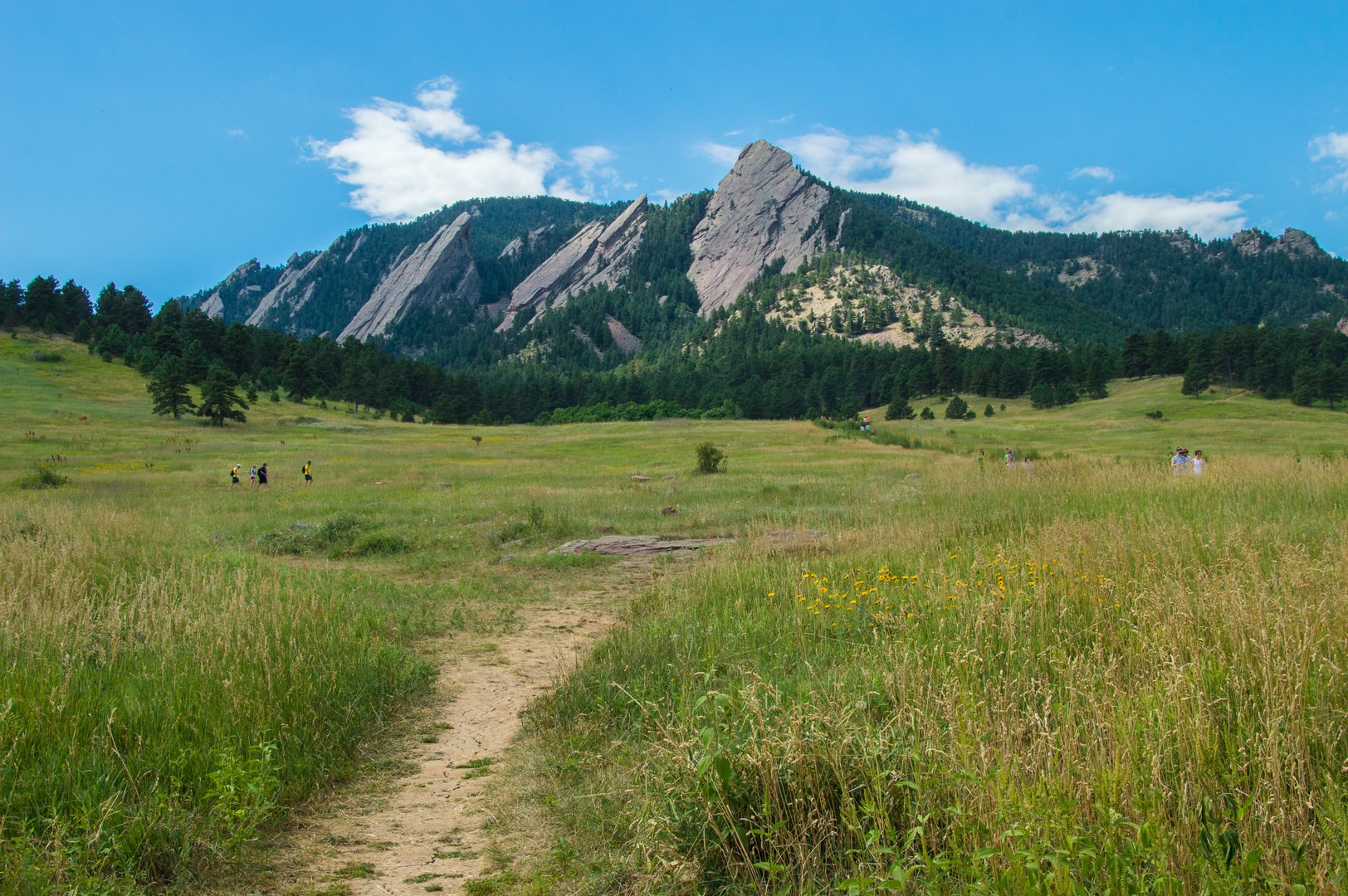You are here
This is the main route up the First Flatiron, and it may be the single most popular multi-pitch trad route in the Boulder area. Despite the lack of novelty, it is no doubt a classic climb that deserves every bit of the traffic that it gets. It is located just outside Boulder in the ever-crowded Chautauqua Park. It's worth fighting the crowds, though, to scale the titanic slabs that feel like granite but are actually a kind of condensed sandstone. Standing on top grants you panoramic views of Boulder, Fort Collins, Denver, the Second and Third Flatirons, and the mountains of the Front Range.
The Direct Route is approximately 1,200 feet of pure fun that utilizes the longest possible route up the First Flatiron, which is the furthest north of the large triangular faces. It's difficulty rating is 5.6 R, meaning the climb is relatively easy but protection is scarce in many places. It requires cams, stoppers, hexes, slings, and other trad gear for protection and anchors, but a few bolts can be used on the first pitch. The most difficult part of this climb for most people is following the typical route. The Flatiron is an ocean of rock that can be climbed just about anywhere, so searching for the path of least resistance can be daunting. Many climbers accidentally wander off route and find themselves on much more difficult or run-out climbing than they bargained for. For your first time on the Flatiron, you should go with someone who knows the climb or closely follow the description below and be prepared to do a bit of route finding.
The Route
Approach: Park in Chautauqua Park, or on the street nearby if the lot is full, and hike up the obvious Chautauqua Trail toward the rock. Follow the defined path and signs leading to the First Flatiron climbing access. After crossing a wooden bridge, the route begins at the base of a staircase against the rock.
Pitch 1 (5.6): Follow the shallow ridge of rock past two glue-in bolts, then work a bit left and finish at a small tree on a ledge. A variation is to start further left, using an old bolt as protection. This alternative is slightly easier climbing, but it is not protected as well. The pitch is almost a full 60-meter rope length.
Pitch 2 (5.6): Stay calm and pad your way up 180 feet of pure slab. The climbing is easy and fun, but protection is scarce. Be prepared for a major runout here. The pitch ends at a partially detached flake that forms a small ledge. This can be hard to spot from below, so don't worry if you miss it. Other anchor options exist to the left or right, roughly one 60-meter rope length from the last belay.
Pitch 3 (5.5): This pitch looks intimidating because the angle is steeper, but the rock is actually much more featured and the climbing slightly easier. Travel straight up, finding the path of least resistance. After going nearly a full rope length, belay from any of a few small ledges with good protection.
Pitch 4 (5.4): Look up to find the large rectangular block jutting out to form a roof in the headwall above. Travel up and around this feature to the right, then work back left on featured rock to finish on top of a huge ledge.
Pitch 5 (5.3): From here on, route finding gets easier. Leave the ledge, walking and scrambling up and left through a series of ramps and low-angled slabs as you aim for an obvious notch in the roof overhead.
Pitch 6 (5.6): Go up through the notch. The climbing here may feel a bit wild compared to the rest of the route, but it protects well. Continue up the crack system to the top of the spine and begin working left up the ridgeline until you reach a comfortable belay spot.
Pitches 7-10: The rest of the climb can be pitched out in a variety of ways, depending on how you decide to split it up. Belay spots are numerous, so just stop at sensible places to maximize safety and minimize rope drag. The terrain here on the summit ridge is mostly fourth-class scrambling up and down, but it has two steeper slab sections. These can both be scaled like face climbs and protect fairly well. Finally, there is a V0 boulder problem guarding the summit.
Once on top, take in the views and sign the summit register. Rappel anchors are obvious, and the rappel drops down the backside of the rock, easily reaching the ground with a 60-meter rope. Be careful with your rope toss because hikers frequent the trail below, then enjoy your free-hanging decent past golden-streaked walls.
Take the well-traveled trail to the south (rappeler's right) back down the the bottom of the Flatiron and the parking lot.
Gear: Bring a standard rack of your favorite pieces. Protection is generally good when it can be found. Extra slings are recommended for places where you might have to wander a bit to place protection.
Note: If the Direct Route seems like a bit much for your party's comfort level or time window, you can start further right, past the top of the staircase, and cruise up run-out 5.2/5.3 terrain to the right of a large gully, which can itself be climbed at 5.3. Upon topping out the spine you can either downclimb the backside for a shortened Flatiron experience or continue up the ridgeline to the summit. This is known as the East Face North Side or the Far Right Route.
Logistics + Planning
Current Weather: Powered by Dark Sky






























Comments
Sign In and share them.